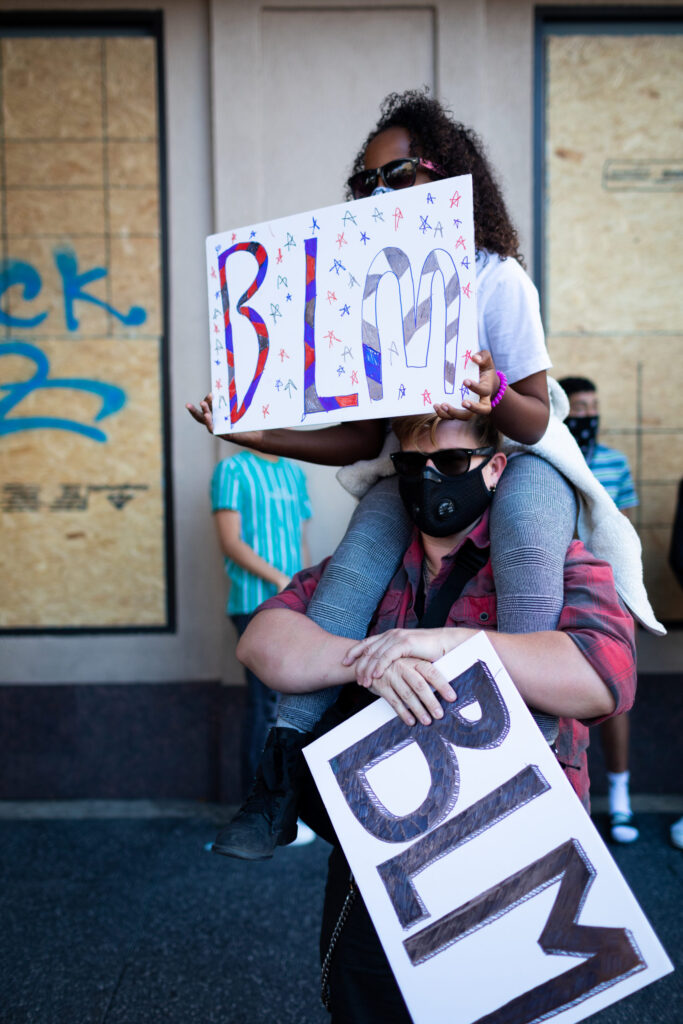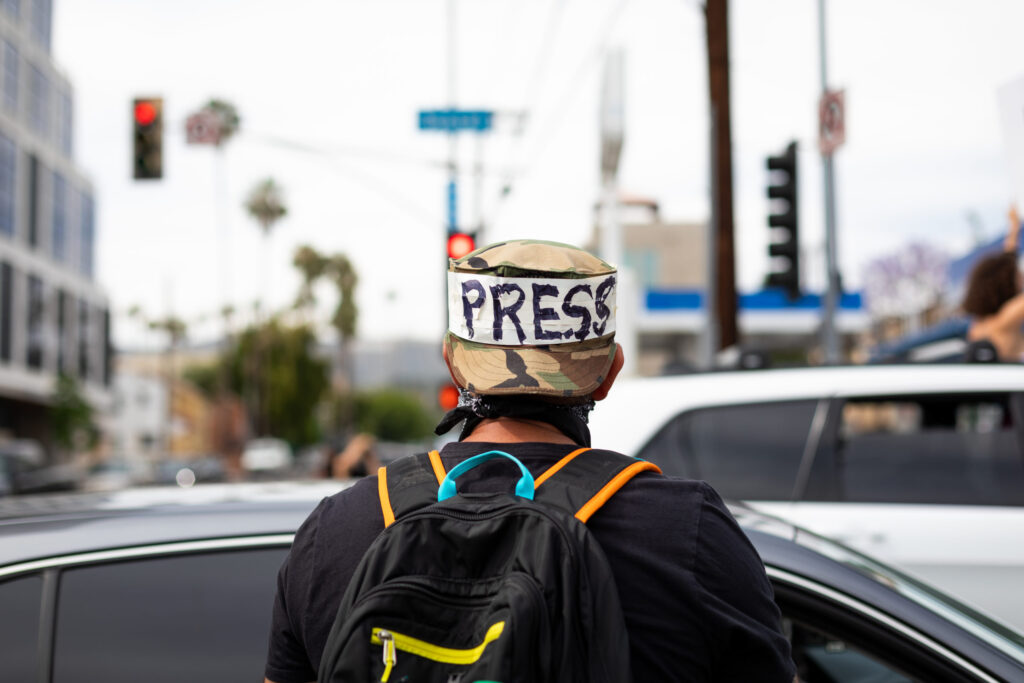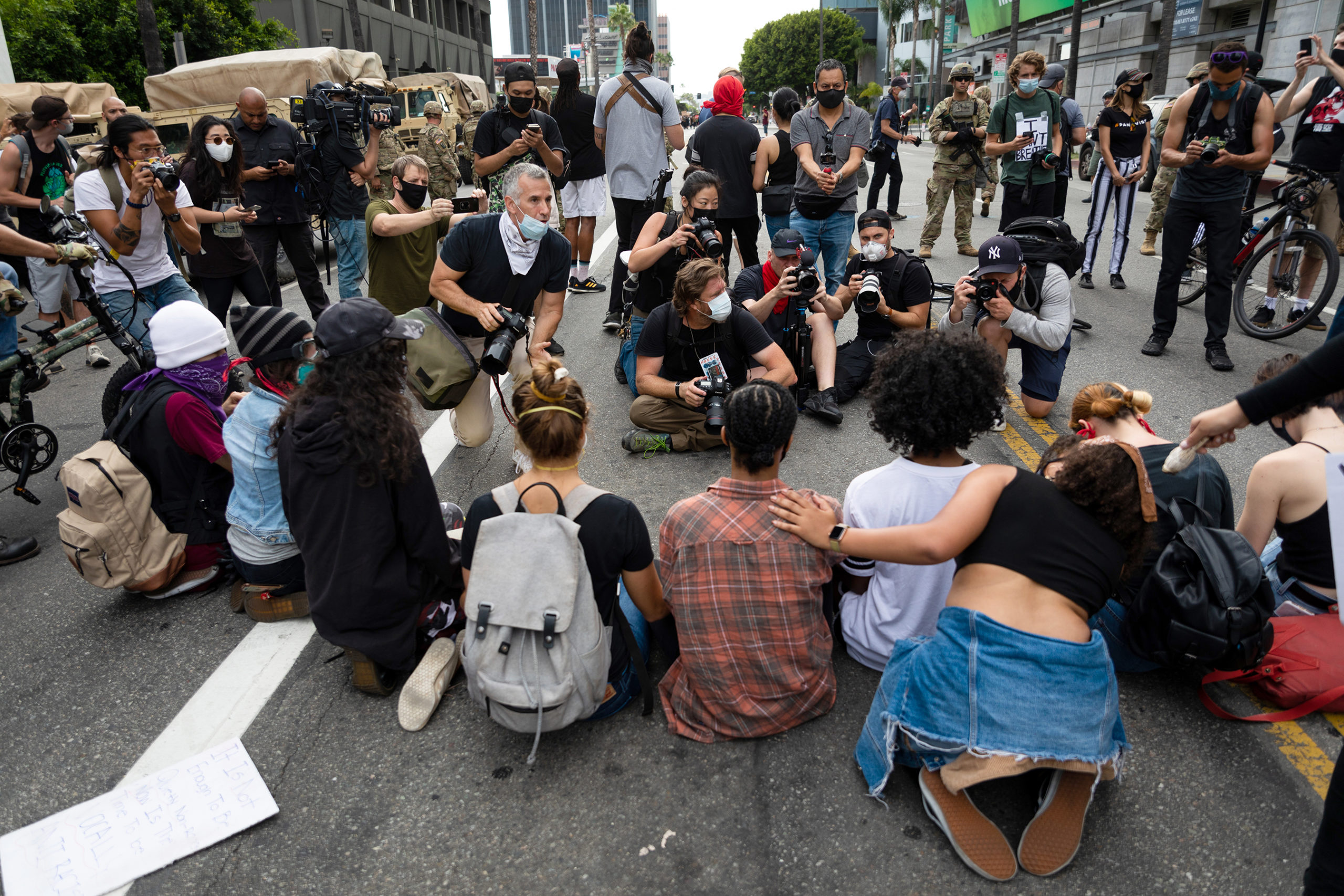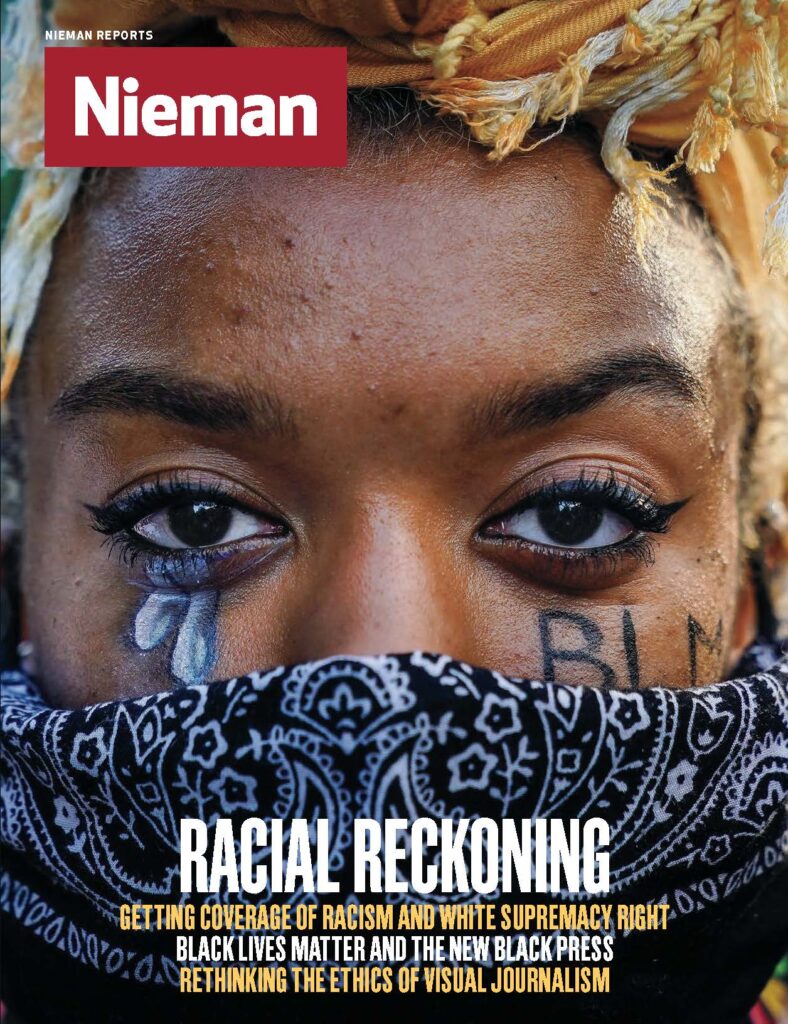On June 7, 2020, hundreds of people gathered on Hollywood Boulevard to protest the extrajudicial killing of George Floyd and the ongoing public health crisis of police brutality in the United States. Amidst the throng of protesters — many screaming unanswered calls for justice through face masks, and others posed as tableaux vivants atop gilded lowriders — two figures steadied themselves against a boarded-up building facade. With graffitied epithets at their backs, the 10-year-old Black girl and the queer white woman carrying the girl on her shoulders held signs bearing the same rallying cry that has, since 2013, mobilized communities against anti-Black police violence: Black Lives Matter.
Seeing an opportunity to capture a moment of stillness amongst raucous and joyous displays of solidarity and rage, a white male photographer rushed over to the pair. With expeditious skill, he stepped directly in front of a Black female photographer he didn’t seem to notice (threatening both her balance and her attempts at social distancing in the crowd) before swinging his camera up to eye level and firing off a few successive shots of the woman and child before walking away.
Despite them being no more than six unadulterated feet away, the man neither addressed the two protesters, nor asked for consent to photograph the minor, a standard practice in photojournalism.

That photographer he jostled to get his shot was me (Tara Pixley), and the child he photographed was my daughter, Brynne.
I understood the desire to document this moment that spoke to the intimate frictions between Black life (my daughter’s small, vulnerable body) and white advocacy (my partner’s strong white shoulders supporting and balancing my daughter). Moving from desiring to documenting, however, animates frictions both more and less intimate, a cascade of hidden but material risks and perils that fills the gap between photojournalism as witnessing and photojournalism as extraction.
This particular interaction (or lack thereof) can stand in for some of photojournalism’s extractive practices: wherein photographers are emboldened by their benevolent intent of social documentation and feel so entitled to the lived experiences of the public as to not bother engaging in conversation with those they photograph.
As protests for social justice continue to spread with an urgency and frequency not seen in the U.S. since the Los Angeles riots of 1992, the photojournalist community has become embroiled in heated online debates about the ethics of photographing and publishing images of Black protesters in news publications. These concerns are situated amongst ongoing threats to journalist safety and waning public trust in news media that mark photojournalism’s precarity.
Related Reading
Some argued for normalizing informed consent as a practice whereby visual journalists take care with those they photograph, asking for consent to take their image and informing them where such images might be published. Others argued for the need to blur or hide faces of protesters on the publication side, protecting the anonymity of the most vulnerable (i.e. Black, brown, Indigenous, trans, and queer). Another group of photojournalists — that skewed White, male, and older with few but notable exceptions — insisted that neither practicing informed consent nor concern for protesters’ identities should be expected of photojournalists working in public spaces.
The latter argument is grounded in fear of already-eroding press freedoms that might be exacerbated by potential limits on journalists’ First Amendment right to photograph any and all in public spaces without their knowledge or consent. This is a conversation among photojournalists about the standards of their profession, but it should also be a public conversation that invites the thoughts and demands of those whose likenesses may, with or without their consent, be circulated.
Photography’s history of racial violence
The visual politics of photojournalism are, and have always been, deeply embedded in carceral systems of control. The birth of photography as a medium coincided with the expansion of America’s plantation economy and the civil unrest produced by its legacy of racial violence enacted on enslaved peoples. In experimenting with this new medium for “seeing” and visualizing history, early photographers did not innocently or objectively document the “truth” of chattel slavery, but rather participated in the visual culture of American enslavement by staging photographic visions (and social fictions) of racial hierarchy: slave owners commissioned photographers to produce daguerreotype portraits of their slaves.
This was a quotidian practice that further naturalized the hierarchical relationship between slaveholders and their enslaved property. While these portable surrogates of the enslaved simultaneously performed evidentiary work for slaveholders to prove ownership in the 19th century and often staged scenes of benevolence (e.g. images of Black slaves and white children under their care), the afterlife of these images continues to haunt slavery’s descendants. As political tools, however, fugitive photography and runaway slave portraiture worked to visualize the liberatory futures of abolitionists as well.
A lack of nuanced reflections about what constitutes “truth” or “legitimacy” in photojournalism reinscribes the myth of photographic objectivity
In drawing together these incommensurate political projects (abolition versus the status quo of enslavement), America’s anti-Black foundations illustrate the photographer’s dual complicity in scenes of subjection and liberation. The arc of the archive, however, bends heavily toward state-sanctioned mayhem rather than salvation.
This is woefully evident in the case of lynching photography. Following congressional Reconstruction, photographing lynchings became a banal practice of witnessing and documenting the racial terror enacted on Black and brown people in the form of public, extrajudicial displays of mutilation and murder. These gruesome images of lynched Black men and women not only visualized the brutality of anti-Black violence, but worked to produce and sustain the sociocultural optics of white supremacy as they circulated in the form of postcards. Delivered through the United States Postal Service mail, these images would end up on kitchen tables, affixed to walls in the family home, or sent as loving keepsakes to faraway family members.
James Allen and John Littlefield published one of the largest collections of lynching photographs in the 2000 book Allen edited, “Without Sanctuary: Lynching Photography in America,” making accessible the words of lynching attendees often written on the backs of postcards. One attendee, “Joe,” describes his experience witnessing one such spectacle of Black death with apparent glee:
“This is the Barbecue we had last night My picture is to the left with a cross over it your son, Joe.”
Perhaps more distressing than Joe’s sociopathic description is the fact that local photographer Fred A. Gildersleeve, who captured the horrifying murder of 17-year-old Jesse Washington in Robinson, Texas, had been tipped off by the town’s mayor, allowing him to set up his camera in advance of the lynching. Gildersleeve was then able to rapidly print and sell postcards of Washington’s broken body as macabre souvenirs.
In her recent piece in The Conversation, Allissa V. Richardson addresses the history of lynching photography and its relationship to contemporary recordings of extrajudicial killings of Black people like Ahmaud Arbery, Rayshard Brooks, George Floyd, and Breonna Taylor. Richardson describes that, in doing research for her recently-published book “Bearing Witness While Black: African Americans, Smartphones, and the New Protest #Journalism,” such spectacles re-traumatize those who witness them. She argues that treating citizen-recorded images of Arbery and Floyd’s final moments with a reverence usually reserved for lynching photography might help a viewing public regard images of Black death with more care.
Critiques of Richardson’s argument inundate the comments section, revealing a predictable backlash by many photojournalists who see the work they do as a fundamental democratic imperative to tell the “truth” by not looking away from horrors or relegating these images to the “back stage” of the archive. These responses illustrate how a lack of nuanced reflections about what constitutes “truth” or “legitimacy” in photojournalism reinscribes the myth of photographic objectivity.
We argue, however, that acts of witnessing — whether we are photojournalists, scholars, policy makers, or police officers — invite us to see how our own subjective interpretations are entangled with visual practices that emerge from historical configurations of settler colonial policies. Furthermore, these historical lenses for contemporary photojournalism are not limited to the gaze of the photographer or the meaning of the photograph, but continue to be leveraged in service of ongoing domestic surveillance projects.
Photography as surveillance
Scholars like Ruha Benjamin, Simone Browne, Kelly Gates, and Shoshana Zuboff have articulated the vast and troubling intersections between surveillance structures, big data, and the role of the visual across digital platforms. The surveillance state apparatus continues to expand its use of biometric and photographic data, from mining social media feeds to investing in private partnerships between law enforcement and companies like Target and the Amazon-owned doorbell-camera company Ring. These symbiotic relationships are far from innocent, and should be at the forefront of conversations in photojournalism more broadly.
This is especially important because many people use social media as their main source of news content, which has encouraged news organizations to use social media platforms to publish their coverage of breaking news. Moreover, internet algorithms search indiscriminately, not differentiating between photojournalism published on news media websites or citizen documentation published on Instagram. This means that the vast social media databases of images, location data, and various intelligence on public movements, actions, and commentary we already know to be in service to police surveillance also includes news images and captions.
Police have admitted to using digital public image archives inclusive of news photographs to identify protesters
The evidentiary work of photojournalism is not only in its telling of “the truth” to the general public but also in its relationship to broader systems of punishment and social control. In George Holliday’s videotape recording of Rodney King’s beating in 1991, what appeared to be clear evidence of police brutality became, in fact, evidence for the state to criminalize King’s futile attempts to protect himself from the officers’ brutal attacks. As of this writing, more than 10,000 people protesting police brutality since May 25th have been arrested or cited for continuing to peaceably assemble after curfew. It is not a stretch to imagine how published photographs of these protesters (which are often time and location stamped in the metadata whether photojournalists include this information in the accompanying caption or not) could be leveraged as evidence in future trials. This is not to say such an action is explicitly and continually taking place, but to point to the possibilities that exist at the intersection of a police surveillance state and an uncritical photojournalistic approach.
For example, on June 4, three Nashville protesters were charged with “felony aggravated rioting” for standing on police vehicles. While the charges were later dropped, they were originally made possible through police acquisition and review of readily available images from various platforms online. A recounting of the events from the police perspective insinuates published news images were some of the photographic intel utilized in service of identifying and incriminating protesters, two of them prominent Black activists.
Police have admitted to using digital public image archives inclusive of news photographs to identify protesters. Furthermore, some organizations are financially incentivizing the public to provide incriminating photographic evidence of perceived wrongdoing or actual illegal activities to charge protesters, which has been a disturbingly successful tactic. Such circumstances illustrate the need for a photographic ethic that considers the stakes of publishing images and other identifying information of people from communities that have been historically surveilled and criminalized by the U.S. government.
Black and brown individuals and communities are increasingly endangered by the intersection of ever-evolving surveillance tech and tactics with the proliferation of vast and readily available documentary imagery online. These tactics are also evolving in spaces typically out of public view. In my (Christina Aushana) research on police training, I found that news images of protests also make their way into police academy training, becoming a part of lecture slides used to teach police recruits how to see and recognize what scenes of “civil disobedience” look like.
These images live alongside cinematic images used to train police officers, such as scenes from Antoine Fuqua’s 2001 Hollywood film “Training Day,” revealing how photographic and filmic images of protest and dissent have a long afterlife in the archive of police training beyond the photographer’s control. This circulation of images, while not public, is condoned by and interpreted within police training. More subterranean and gruesome are instances of officers using published images in Reddit police forums and police message boards like Thee Rant as fodder for racist and sexist commentary.

Photojournalism’s responsibility
Historians of visual culture, critical race scholars, and Black feminist theorists have long articulated the dangerous intimacies between image-making practices and projects of colonialism. The most celebrated, award-winning figures in photojournalism have been frontline photographers shooting the lived experiences of war alongside their armed counterparts in both American and foreign military forces. Yet the industry at large struggles to grapple with its historical complicity in the very conflicts its practitioners seek to document.
We are not advocating for an end to visualizing and witnessing violence, but rather calling photojournalists to reflect on the intersecting histories of anti-Black violence, imperialism, and colonialism that have shaped the practice of photography. In this particular moment, photojournalists are increasingly co-witnesses to racial violence enacted by the police — standing alongside and with protesters in a social position that demands analysis, internal reflection, and collective discussion.
What is brought to the foreground, relegated to the background and what is rejected from or accepted for inclusion in the camera frame are all conscious choices made in the field by the photojournalist. If such choices can be made in service to a favored aesthetic and an intended story framing for future publication, why can’t they also be made in consideration of their impact on the individuals photographed?
The conflicting stakes of the work done by photojournalists has never been higher: the importance of expansive and thorough reporting on these protests is both integral to the widespread recognition of the Black Lives Matter movement and as a site of potential state subjugation. Each image photographed, published, and circulated has the capacity to both inform a viewing public and inform the police.
We need to turn our critical attention to how such visual practices are co-opted
What is the responsibility of photojournalism to its public?
The clarion call to journalism has been to document the truth, but the contemporary visual media sphere has become far more complicated than the idea of a single truth as vetted and circulated under the purview of the professional eyewitness.
Photojournalism in an increasingly surveilled society must attend to the broader surveillance mechanisms and policies that further threaten the criminalization of Black and non-Black people of color. Taking identifying photographs or video of Black participants’ full faces as a mode of “visualizing” their participation is in service to neoliberal narratives of inclusion and diversity. We need to turn our critical attention to how such visual practices are co-opted and, in fact, generate data for discriminatory artificial intelligence systems. What we have sketched out is a broad stroke schematic of platforms, structures, archives and communication networks through which photos circulate, often beyond our control.
In “There’s Less to Portraits Than Meets the Eye, and More,” Teju Cole nodded to how portraits of Black people specifically can evince empathy and depict the “indelible news of (their) reality,” especially when Black people have some agency or collaboration in imagemaking, such as in Sojourner Truth’s impactful 19th-century portraits. But he also ruminated on the dual uses of portraits: both endearing us to one another and capturing our specificity used in service of today’s surveillance and access technology.
It is precisely this tension that Cole describes in his final piece as photography critic for The New York Times Magazine. He writes, “without confronting this inequality, this misconstrual of history, photography will continue to describe itself as one thing (a force for liberation) while obdurately remaining another (an obedient appendage of state power).” When we fail to engage this complex duality at the core of photojournalism, we fail to harness the liberatory possibilities in our image-making. In squarely facing the complicity of the photojournalism industry in scenes of inequality and racial violence, we give ourselves an opportunity to turn toward more responsible, redemptive acts of witnessing that can better serve the public.
Beyond journalism
Visual journalists who refute the value of consent in their practices with vulnerable communities inherently undermine the agency of those Black and brown people photographed. The news photography industry must attend to the digital circulation of images beyond the intentions of journalists and the space of news media production.
Upholding journalism’s democratic purpose and re-engaging public trust requires a revamping of visual documentary ethics, including a far more critical and comprehensive reconciliation of the public’s rights and responsibilities with a free press’s rights and responsibilities. This is most possible through embracing photojournalism as a collaborative process with those photographed, wherein informed consent and mutual respect are normalized.
There is incredible value and power in visually documenting racial justice movements, in creating and widely publishing images that inspire empathy and collective action via the impassioned faces and acts of the too-long-oppressed. There is also immense power and value in taking care with those photographed, in acknowledging the humanity and agency of those whose plights photojournalists depict under the purview of alerting the public to injustice. In fact, how can there be one without the other?
If news photography intends to draw our attention to social injustices, so too must photojournalism draw attention to injustice written into the professional ethos of its own practices.




